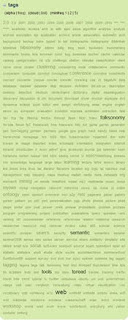Our latest
major release brought up completely redesigned
publication posting and editing dialogues. The changes in the underlying backend system are even bigger than you as end-user might notice. With this week's feature I want to introduce the new dialogue for editing publications.
You can test the dialogue yourself, by
copying this post. The emerging web page will look similar to this screenshot where I have highlighted the five main parts I will explain in the following:
general information
This box contains the main fields you must fill out for
every publication in BibSonomy:
entry type, BibTeX key, title, author(s) or editor(s), and year. For the
entry type you can choose among a list of the types supported by BibTeX, i.e., "article", "proceedings", "phdthesis", etc. The
BibTeX key uniquely identifies the publication reference in your document and is used to cite the reference (e.g., with the
\cite{key} command in LaTeX).
The small blue button next to the BibTeX key allows you to generate a new key - if the one which has been extracted is not easy to remember, for example. We use the first author's last name, the year and the first longer word from the title to generate the key. In the example above the generated key would be "haveliwala2003topicsensitive".
tags
Here you can enter tags (freely chosen keywords) to describe your post and ease later retrieval of it. Since
tags are the main ingredient of a social bookmarking system, they are a required field, too. Our
tag recommenders help you to find meaningful tags - just click on one of the recommended tags to add them to your post. Hint: you can also click on the tags in your tag cloud on the right side - they are then added to your post, too.
groups
The following two boxes entitled
viewable for and
relevant for are part of BibSonomy's support for
(research) groups.
viewable for
You can restrict which users can see this post. Either everybody ("public"), only you ("private"), or your friends ("friends"). If you are member of a
research group, you can also allow only members of the group to see the post. We will soon allow posts to be visible for several such groups.
relevant for
As member of a group you can explicitly state that the post is
relevant for this group. Such posts then appear on the
/relevantfor page, e.g., for the group
kde on the page
/relevantfor/group/kde.
More on this feature in
this blog post.
detailed information
All other metadata that belongs to a publication is stored in these fields. Note that only the fields that the typical styles for BibTeX use for the selected entry type are shown. You can show all fields by clicking on the respective link at the top of this box.
comments and notes
Here you can enter personal notes or comments about the publication. Why three fields for that?
Well, the first field (
description, comment) is not a feature of BibTeX but the description field every post has in BibSonomy - also the bookmarks. Just enter your notes, comments, thoughts on the publication into this field.
The second field (
private note) contains your private comments - only you can see its contents.
And the third field (
note) is used by BibTeX. Typically, everything you write there is inserted into the publication reference in your literature list.
scraper information
Actually, sometimes there is a sixth box that is not shown in the above overview screenshot:
This box only appears if you used one of our
screen scrapers to post a publication to BibSonomy directly from another digital library like the ones from
IEEE or
ACM.
The box shows you which scraper extracted the data from which URL and how the extracted BibTeX entry looks like.
To sum up ...
In our opinion, the new dialogue is much cleaner and easier to use than the old one. All the important facts about a publication are grouped together at the top of the page. Furthermore, now the two dialogues for editing bookmarks and publications have a consistent layout which eases usage of the system.
Feel free to comment. We are very interested in what you think about the new layout.














